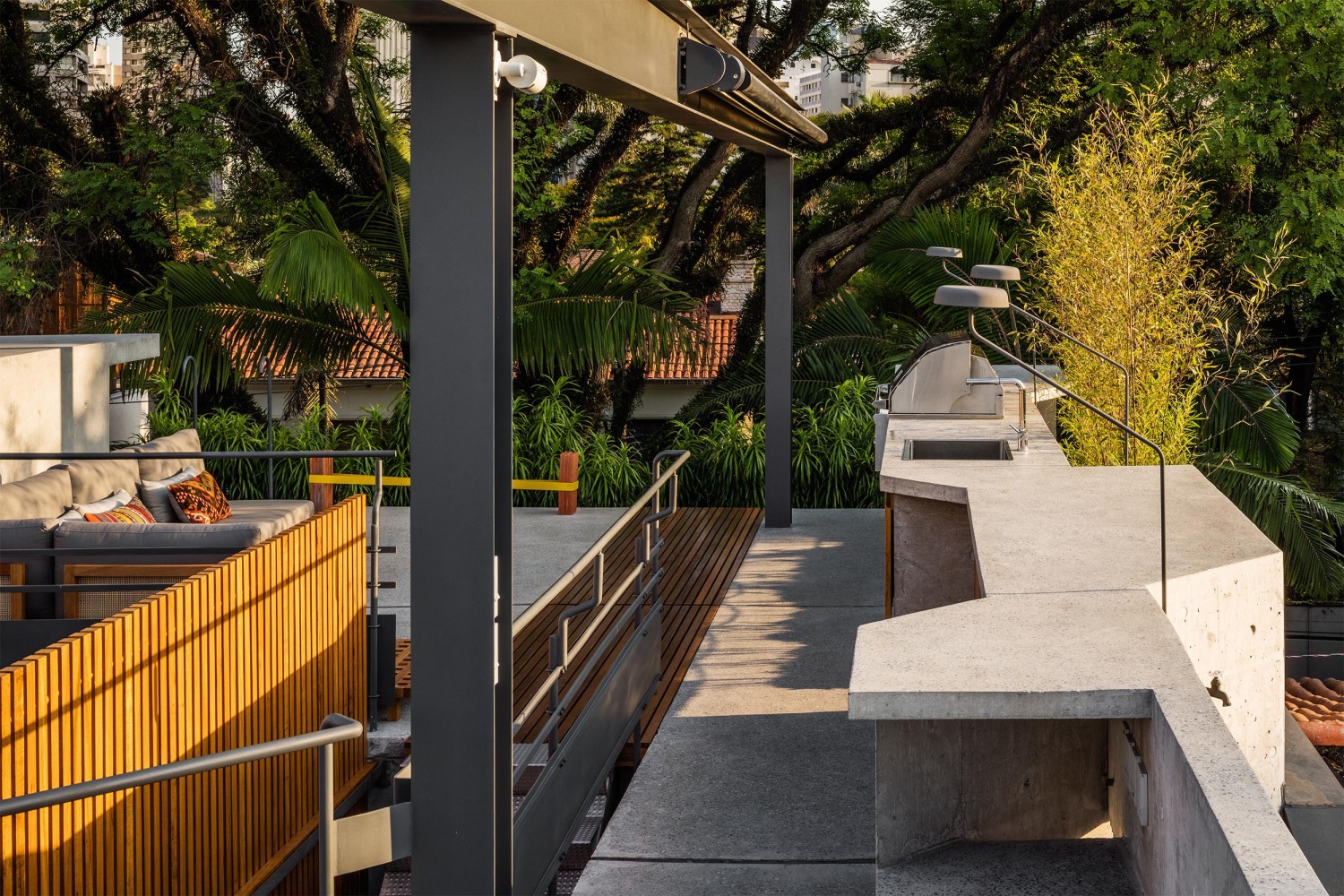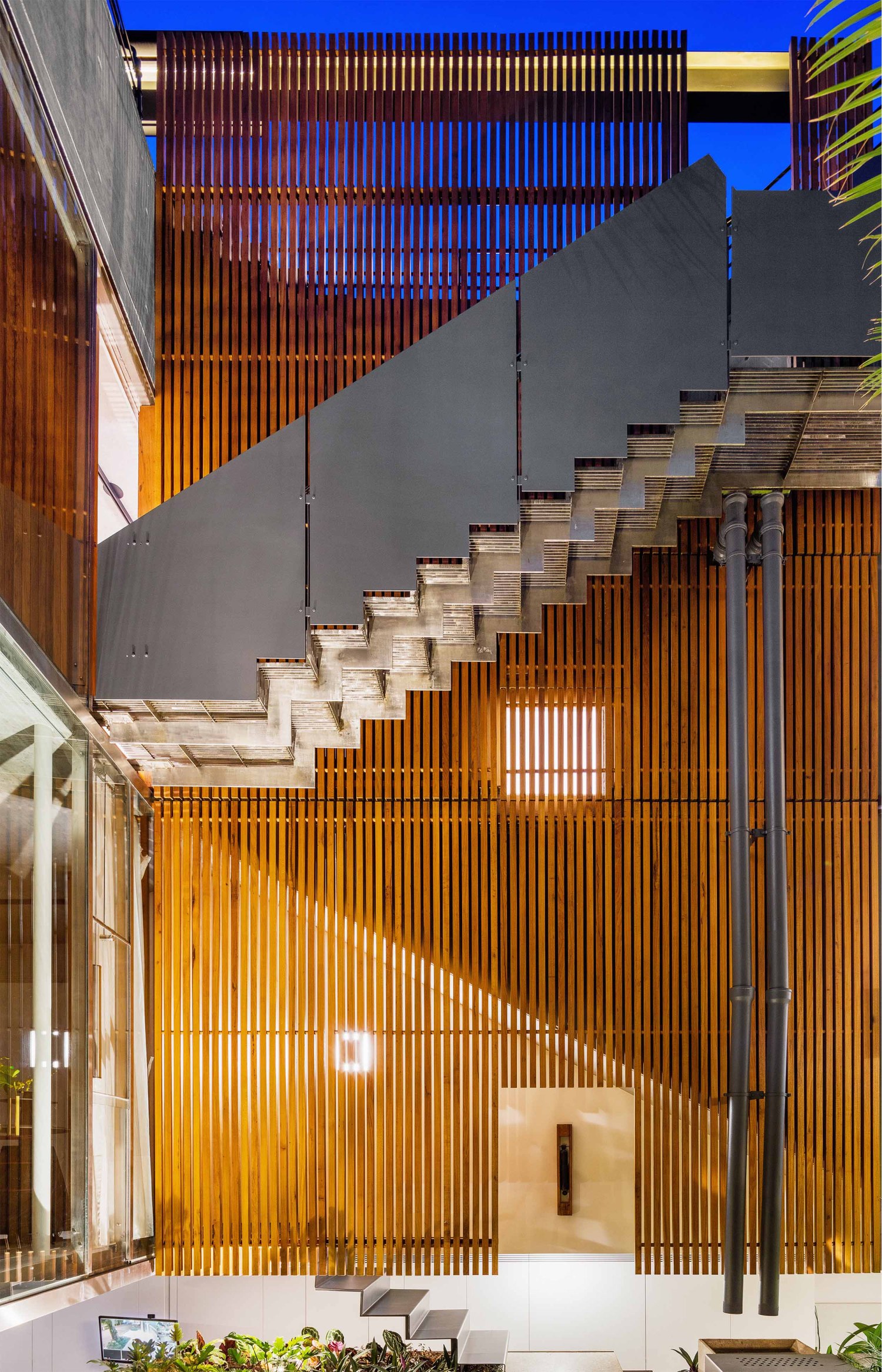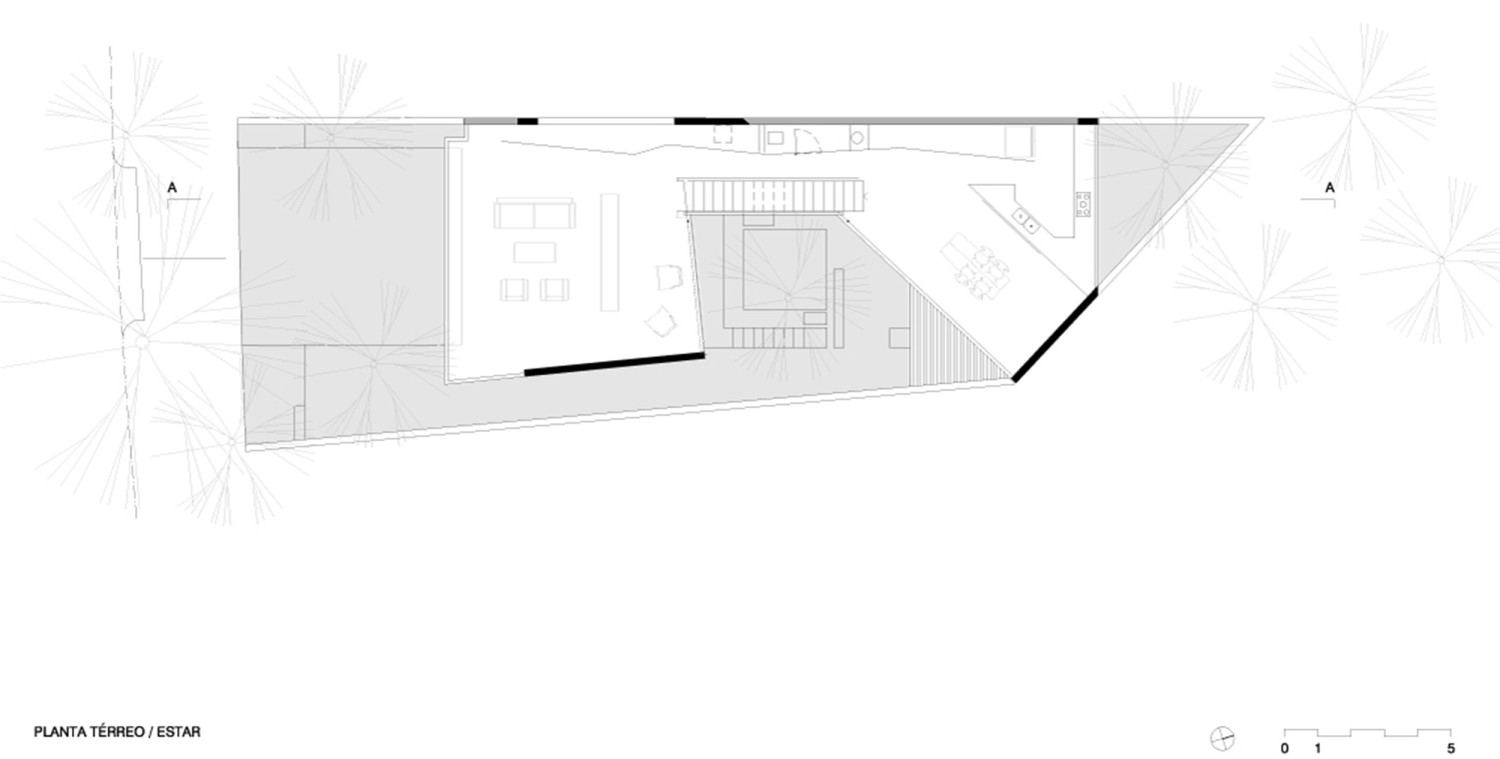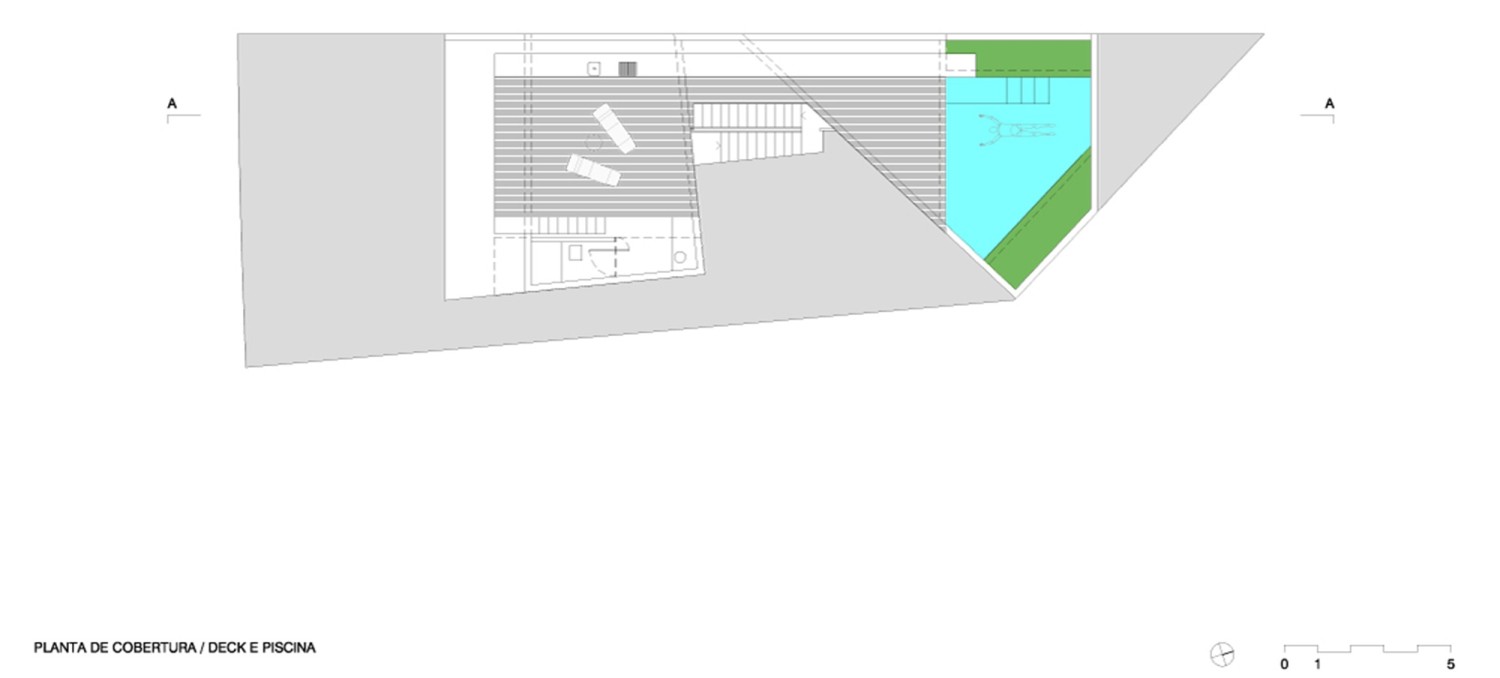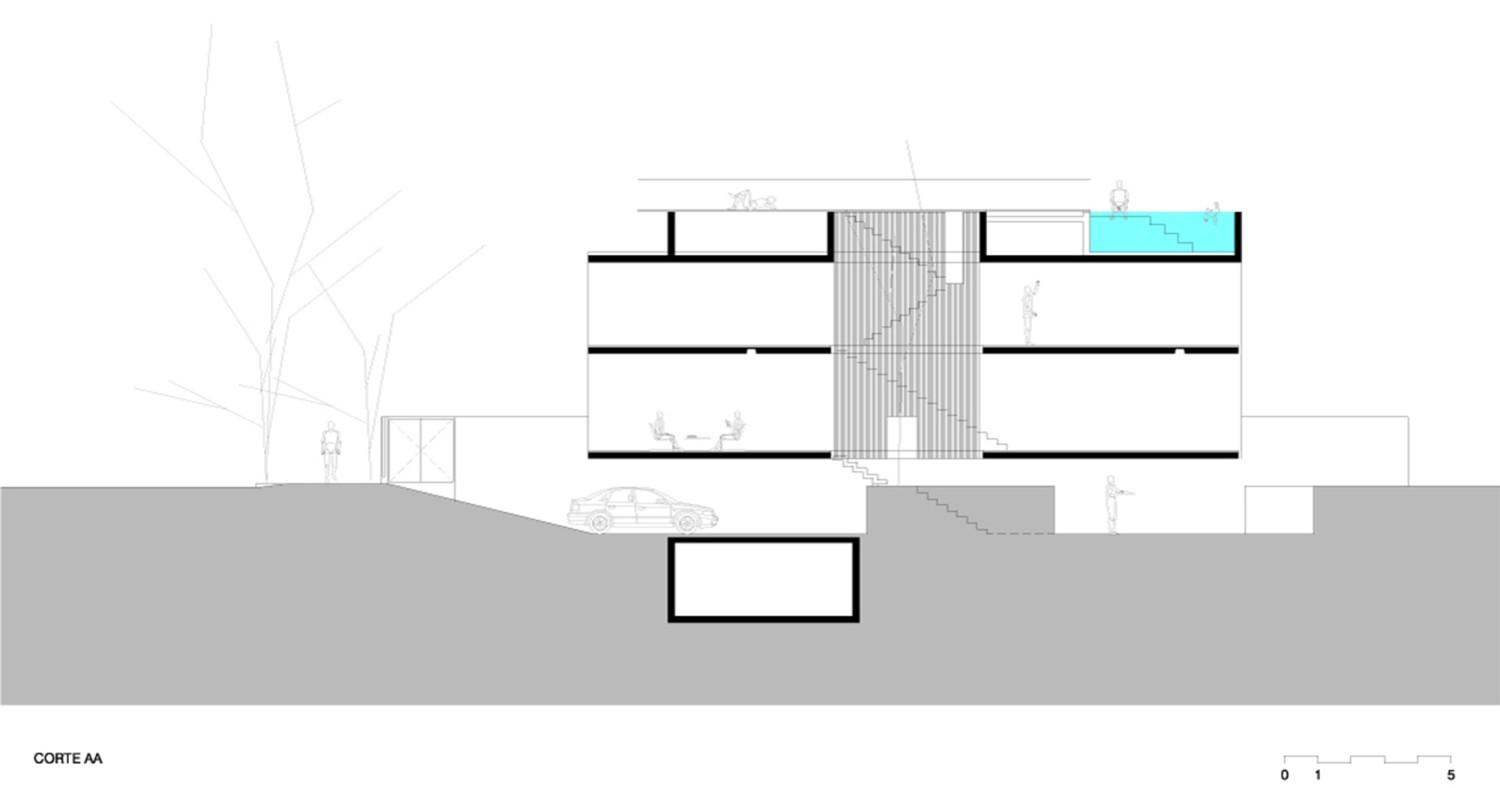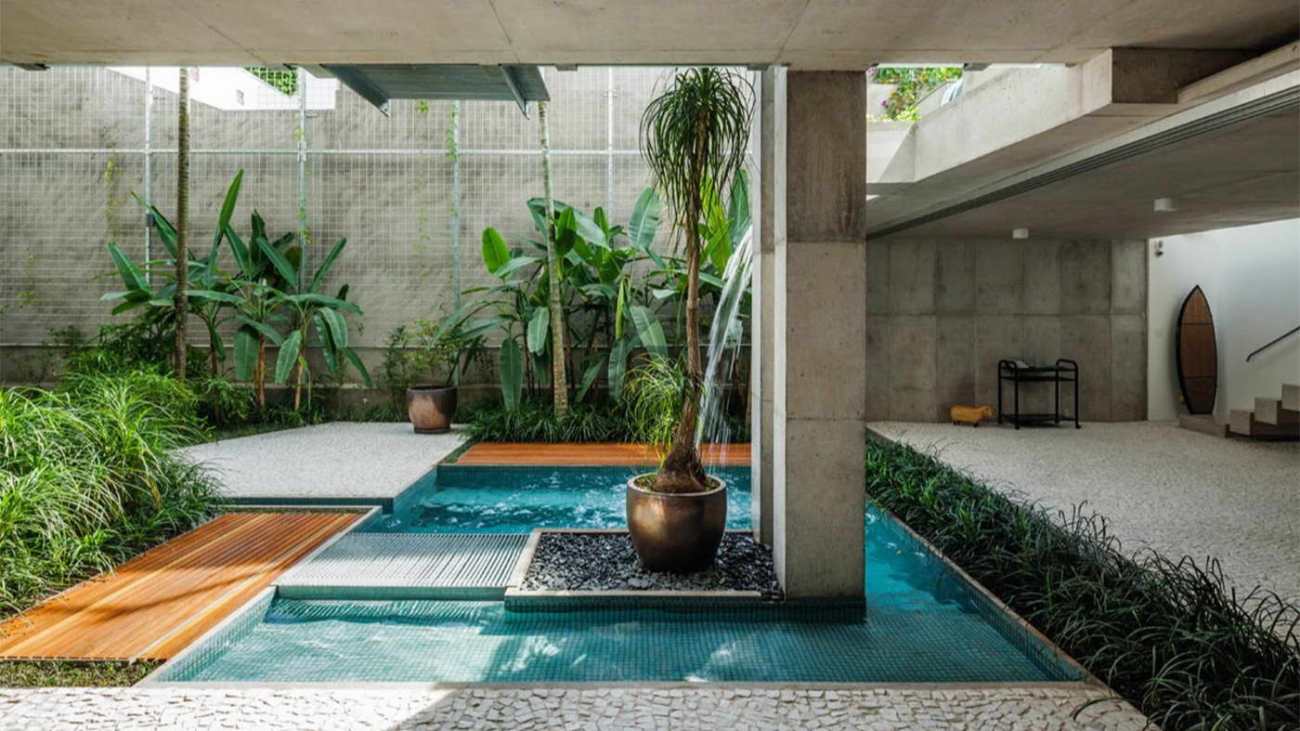项目最主要的设计要点在于: Jardim Europa位于圣保罗,与周围的高楼大厦相比,被视为一座绿色岛屿。这主要源于1940-50年代设计这一地区的“花园城市”原则,并对建筑的规格严格的进行限制,因此天际线由出现在低矮建筑物上的50-70年的树冠定义。440 Belgica街区的地标建筑是一棵15米高的 tipuana树,我们的项目就在此处,230平米的小房子和附近那些典型的大房子形成了鲜明对比,其地形轮廓为不规则的四边形:中间无平行线,也无垂线。
Two contrastsasstarting argumentsfor designing: [1] Surrounded by high-rise buildings, the Jardim Europa in Sao Paulo, is perceived as a greenisland. This scenario came out from ‘garden city’ principles that guided the urban design of this area in 1940-50, and it has been kept due to its strict construction regulations. Its skyline was defined by 50-70 years old trees which emerge above low rise constructions.[2] A 15m high tipuana tree is a landmark on 440 Belgicastreet where this house will be placed. This small lot, 230m2,contrasts with those typically large properties on the neighborhood. Its perimeter is defined by anirregular four sides polygon: no parallel or perpendicular lines in between.
这个社区里的房子是大多是一个个的“盒子”,树和建筑是明显分开的,草地被限制在户外,一进入建筑,我们就会感受到房屋的所有核心空间都被包裹起来,没有采光而显得十分黑暗。但我们的项目不一样,与街道上的建筑概念相反,项目的建筑与绿化相结合,其策略是把这个建筑“盒子”展开成一个更平滑的“平台”,让它流过树木。
At that neighborhood, houses have been made as boxes, in such a way that trees and constructions are clearly separated. Green is restricted to outside. Once inside a house, one knows, its core is fully built, it tends to be dark.A concept that guided this proposal is the opposite. The goal issomehow to merge inside and outside, or construction and green. The strategy was to unfold a box into a more fluid slab as flowing through trees.
这个假设很简单,但是要实现它却很困难。因为所有的土地面积大小都受建筑规范的限制,所以这些规范基本定义为:
1.最大占用率为50%;
2.230平米的场地上,有1.0 FAR的最大距离;
3.前端必须退让5.0 m,侧边退让1.5 m侧缩进(一侧不需要后退),在半径5.0的圆弧,其中心在背面钝角的边缘,也必须退让。
如果这栋住宅的设计方案需要大的建筑率,这意味着所有层必须完全重叠。
It is quite simple as an assumption but challenging to be achieved. This is due to all restriction of the lot size combined to construction regulations, which define basically:
1. 50% as maximum occupancy;
2. 1.0, or 230 m2, as maximum FAR;
3. 5.0m as front setback; 1.5m as side setback in just one side (not set back required in the other side), 5.0 radius arc with its center placed on the edge of the obtuse angle on the back must be respected as a setback.
Naturally, the program for this house required fulfill the maximum construction rate, that means two floors perfectly overlapped.
▼项目空间退让 PLANTA GARAGEM
所以这就是我们所要面对的挑战:如何在一个几乎没有剩余空间的地方打开这个“盒子”?
Thus, this was our chosen challenge: how to unfold a box where thereseemed to have no space to spread anything?
这个小屋给人的感觉既清晰又简单。其几何形状是由不规则多边形辐射而来。就项目来说,也是一个概念与一个策略的实现。
This small house results quite clear and simple. Its geometry was radiate from that irregular polygon. It is itself just a fragment to test, as a laboratory essay, a concept and a strategy.
项目是一幅穿过树梢的画。
It is one single frame for an image of walking through treetops.
▼项目底层平面图
▼项目一层平面图
▼项目二层平面图
▼项目屋顶层平面图
▼项目剖面图AA
项目名称:House in Jardim Europa
设计单位:spbr arquitetos
项目地点:巴西 圣保罗
设计年限:2015
建造周期:2016-2017
负责人:Angelo Bucci
项目团队:Tatiana Ozzetti,VictorPróspero,Beatriz Marques,Nilton Suenaga,Felipe Barradas,Martha Bucci,Lucas Roca,Miguel Arturo Croce
项目客户:Alexandre Roesler / Renata Muniz
结构工程师:Ibsen Puleo Uvo
机械工程师:JPD
工程师:José Luiz de Paula Eduardo, Apoio Assessoria e Projeto de Fundações S/S Ltda.
结构体系:钢筋混凝土
主要材料:混凝土和玻璃
占地面积:238.96平方米
总建筑面积:372.02平方米
照片来源:Nelson Kon
Project title: House in Jardim Europa
Location: rua Bélgica, 440 São Paulo, Brasil
Design year: 2015
Construction: 2016-2017
Architectural firm: spbr arquitetos
Principal in charge: Angelo Bucci
project team: Tatiana Ozzetti, Victor Próspero, Beatriz Marques, Nilton Suenaga, Felipe Barradas, Martha Bucci, Lucas Roca, Miguel Arturo Croce
Client: Alexandre Roesler / Renata Muniz
Structural engineer: Ibsen Puleo Uvo
Mechanical engineer: JPD
Foundation engineer: José Luiz de Paula Eduardo, Apoio Assessoria e Projeto de Fundações S/S Ltda.
Structural system: reinforced concrete
Major materials: concrete and glass
Site area: 238,96 m²
Total floor area: 372,02 m²
Photos: Nelson Kon
更新日期:2020-07-10 15:43:58
非常感谢 spbr arquitetos 带来的精彩项目, 查阅更多Appreciations towards spbr arquitetos for sharing wonderful work on hhlloo. Click to see more works!








